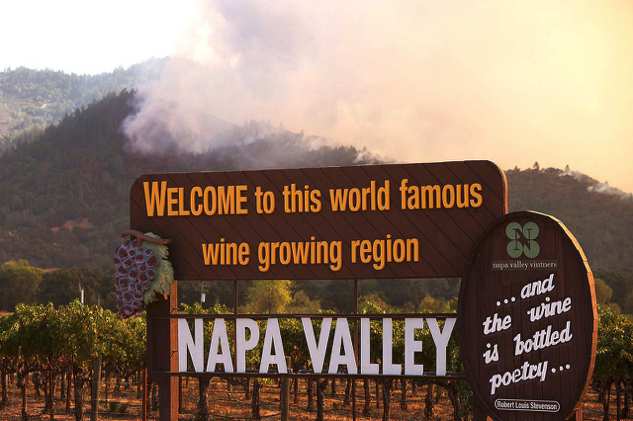
Napa News is a publication of WinelineMedia / WinelineMagazine / © Robert S. Scott / 2023 / Winter Park, Florida, USA
The Napa Valley is world-renowned for its exquisite wines. Each year, visitors from all over the globe come to taste the latest vintages and tour the beautiful vineyards. However, in recent years, the Napa Valley has become just as well-known for something else: wildfires.
Seasonal fires are a natural occurrence in California, but the scope and intensity of the fires have increased in recent years due to the changing climate. This has had a major impact on the wine industry in Napa Valley.
In this post, we will take a look at the history of wildfires in the Napa Valley, how they have affected wine production, and the economic impact of the fires. We will also see how the wine industry is adapting and what the future may hold.
A brief history of wildfires in Napa Valley
Wildfires have been a feature of California’s landscape for centuries. However, the intensity and scope of these fires have changed drastically over the last few decades. The fires have grown larger and spread more quickly, creating a devastating impact on the region. In the Napa Valley, this has been especially noticeable in the last ten to fifteen years. The Valley was hit hard by the 2017 Tubbs Fire, and in 2019 the Kincade Fire caused millions of dollars of damage to the wine industry. The Valley has also seen smaller, more localized fires in more recent years.
How the fires have affected wine production
The wildfires in Napa Valley have had a major impact on the wine industry. In some cases, entire vintages have been lost due to the damage and smoke from wildfires. For example, the 2017 Tubbs Fire destroyed thousands of acres of vineyards, and the ensuing smoke taint was too severe for many winemakers to salvage their product. In other cases, winemakers have had to manage reduced crop yields due to fire damage. The Kincade Fire of 2019 had a major impact on the Napa Valley wine industry, with vineyards losing billions of dollars due to smoke and fire damage.
The economic impact of the fires
The economic impact of the Napa Valley wildfires has been profound. In addition to the direct cost of fire damage, there has been an indirect impact in the form of reduced crop yields, lost tourism revenue and increased insurance costs. For vineyards, the wildfires have led to a decrease in crop yields, which has led to a decrease in income. This has had a major effect on the economies of small towns and villages in the area, as wineries are the primary source of income for many of these commuities.
How the wine industry is adapting
In response to the Napa Valley wildfires, the wine industry is adapting to new realities. Winemakers are working to develop innovative new techniques for protecting their vineyards from fire damage. They are also trying to find ways to reduce smoke taint and recovering wine quality after fires have occurred. Many wine producers have also embraced sustainable practices to protect their vineyards and reduce their carbon footprint.
Looking to the future.
Despite the risks involved, the wine industry is adapting and working hard to protect its vineyards and ensure the quality of its wines. With sustainable practices and innovative new techniques, the Napa Valley wine industry has the potential to continue to thrive long into the future.
Napa Valley is an American Viticultural Area (AVA) located in Napa County in California's Wine Country. It was established by the Bureau of Alcohol, Tobacco and Firearms (ATF) on January 27, 1981. Napa Valley is considered one of the premier wine regions in the world. Records of commercial wine production in the region date back to the nineteenth century, but premium wine production dates back only to the 1960s.
The combination of Mediterranean climate, geography and geology of the region are conducive to growing quality wine grapes. John Patchett established the Napa Valley's first commercial vineyard in 1858. In 1861 Charles Krug established another of Napa Valley's first commercial wineries in St. Helena. Viticulture in Napa suffered several setbacks in the late 19th and early 20th centuries, including an outbreak of the vine disease phylloxera, the institution of Prohibition, and the Great Depression. The wine industry in Napa Valley recovered, and helped by the results of the Paris Wine Tasting of 1976, came to be seen as capable of producing the best quality wine – equal to that of Old World wine regions. Napa Valley is now a major enotourism destination.
The Beginning Early pioneer and settler George C. Yount is generally credited to have been the first to grow grapes in the Napa Valley. In 1864, on the marriage of one of his granddaughters to Thomas Rutherford, Yount gave the couple around 1,000 acres (4 km2) of land, which Rutherford dedicated to winemaking.
Commercial production started in 1858, with John Patchett selling wine for $2 per gallon. His wine cellar, built in 1859, narrowly predates that established in 1861 in St. Helena by Charles Krug, although this is commonly cited as the Napa Valley's first winery.
Captain Gustave Niebaum established Inglenook Winery in 1879 near the village of Rutherford. This was the first Bordeaux style winery in the USA. Inglenook wines won gold medals at the 1889 World's Fair in Paris.
In 1868 H. W. Crabb bought land near Oakville close to the Napa River. Crabb established a vineyard and winery named To Kalon, and by 1877 had planted 130 acres (0.5 km2) and was producing 50,000 US gallons of wine per year. Crabb experimented with over 400 grape varieties to find the types best suited for the area.
By the end of the nineteenth century, there were more than one hundred and forty wineries in the area. Of those original wineries, several still exist in the valley today including Beaulieu, Beringer, Charles Krug, Chateau Montelena, Far Niente, Mayacamas, Markham Vineyards, and Schramsberg Vineyards.
A Top Wine Region In 1976, the region got a boost from the Paris Wine Tasting of 1976, which featured a Napa Valley Chardonnay and Cabernet Sauvignon besting several famous French labels in a blind tasting format. The story of the wine competition, termed the "Judgment of Paris", was made into a Hollywood movie in 2008, called Bottle Shock. The results of this tasting cemented the region's reputation as a producer of world class wines.
Napa Trends A trend of larger national and international companies like E & J Gallo Winery, Diageo and Constellation Brands buying smaller wineries, vineyards and brands began to gain momentum in the early part of the 21st century.[21] Today Napa Valley features more than 450 wineries that grow grape varieties including Cabernet Sauvignon, Chardonnay, Pinot noir, Merlot, Zinfandel, among others. While winemakers may produce wines from specific AVAs within the valley, many wines are made as a blend from grapes grown on the valley floor and the surrounding hillsides.


